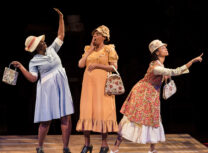William Shakespeare’s Romance Plays

By A Noise Within
February 27, 2020
Shakespeare’s canon of plays can be roughly divided into four basic genres: tragedies, comedies, histories, and romances. Seven years after Shakespeare’s death, John Heminges and Henry Condell published the First Folio, the first published collection of Shakespeare’s plays. The official title of the First Folio printed on the title page of the collection is “Mr. William Shakespeare’s Comedies, Histories, & Tragedies.” This collection was the first time that Shakespeare’s works had been grouped by genre.
Since the publication of the First Folio, interpretations of Shakespeare’s plays have evolved. New interpretations and analyses of the plays have led to the creation of a fourth category for the few Shakespeare plays that do not seem to entirely fit the traditional archetypal mold of a tragedy or that of a comedy—romances.
Shakespeare’s romance plays are a mix of tragedy and comedy. The mark of a Shakespearean tragedy is that the play ends in a number of deaths, onstage and off, while Shakespearean comedies characteristically end in marriages. Romances typically begin as tragedies, but do not end that way. Because of this, romances are often referred to as “tragi-comedies.” The plays that fall into this particular category include:
• Pericles (written in 1608)
• Cymbeline (written in 1610)
• The Winter’s Tale (written in 1611)
• The Tempest (written in 1611)
It is interesting to note that Shakespeare began to write these romances toward the end of his career and the end of his life, as these plays focus greatly on the effects of the past on the present. These plays are imbued with a melancholy tone, and the action of the play tends to center on remedying a past injustice. Forgiveness is central to the endings of the romance plays. While not all of the wrongs committed over the course of the play are righted, much of what is broken is mended.
Romance plays take a looser approach to time than Shakespeare’s comedies, tragedies, and histories. In The Tempest, Shakespeare explores how time functions in narrative storytelling by adhering to what is known as the Unity of Time—that is, that all of the action in the play takes place in the same amount of time it takes for the play to run its course. Conversely, in The Winter’s Tale, Time appears on stage as a character to bridge a sixteen-year gap in the narrative. Reflection plays a key role in these plays as characters grapple with events of the past and embark on a physical or emotional journey toward a place of peace and reconciliation. By the end of a romance play, the surviving characters have changed and matured.
Elements of magic and fantasy play significant roles in the romance plays. These elements contribute to an ambiguous and mystical setting for each of the plays— none of the romance plays take place strictly within the realm of a familiar reality. The elements of magic and mystery complement the transformations that the characters make throughout the play.
Read more from The Winter’s Tale Audience Guide.
Experience Shakespeare’s most magical romance by getting tickets for The Winter’s Tale today!








